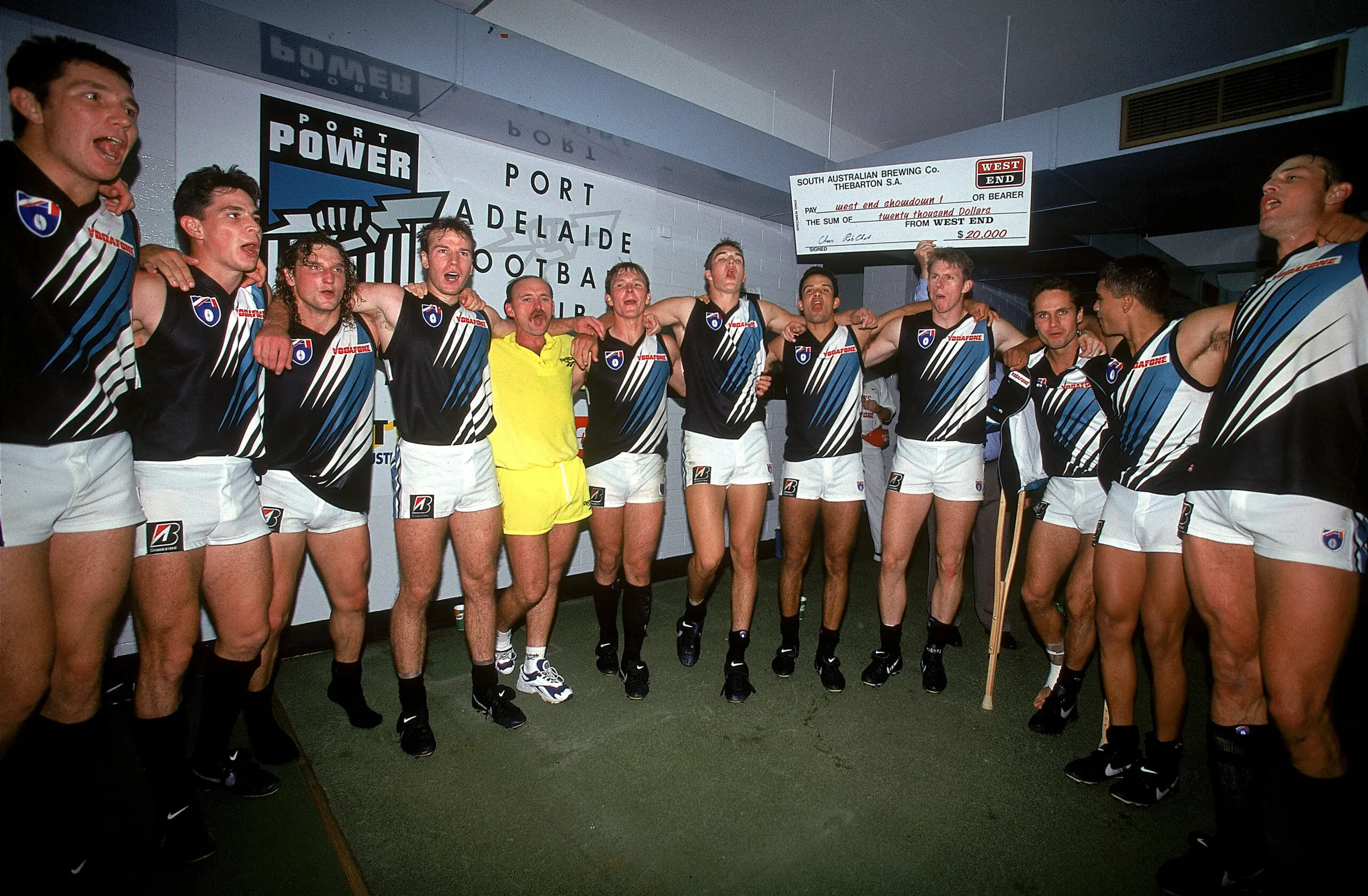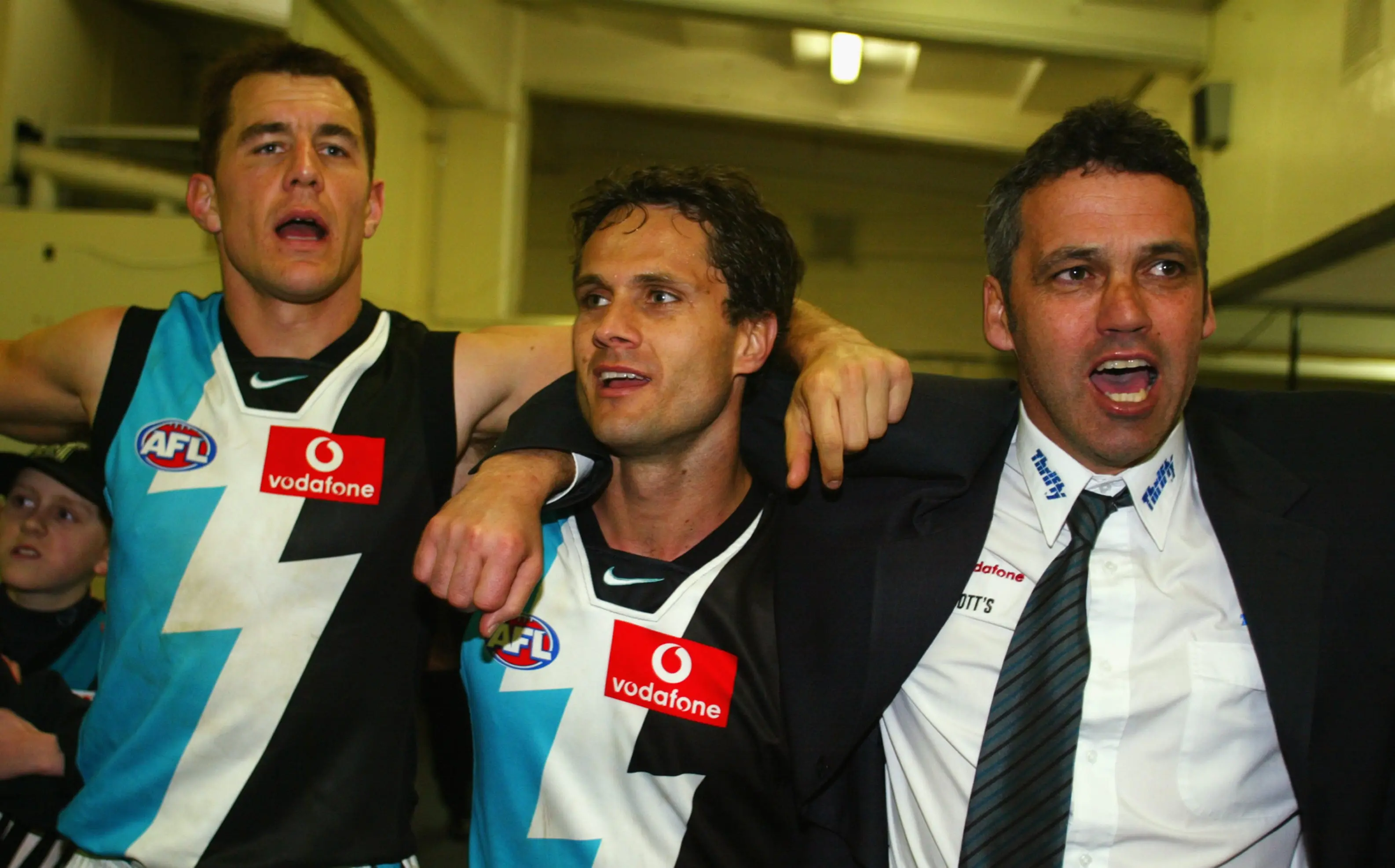When Port Adelaide was fined $50,000 for effectively draft tampering ahead of their debut season, it was the best investment the club had ever made, according to two senior leaders at the Power during its AFL infancy.
The fine was for the new Port Adelaide Football Club paying a handful of young prospects who had emerged through its SANFL team – Warren Tredrea, Peter Burgoyne, Michael Wilson, Paul Evans and Tom Carr – to not nominate for the 1995 draft, a move which would ensure the Power could snare them for free as zone selections in 1996, ahead of their 1997 debut.
While Carr (six AFL games) and Evans (five) failed to establish themselves as AFL players, Tredrea and Burgoyne became Power champions, while the underrated Wilson was regarded as the heart and soul of the club during his 192-game career.
The Power also encouraged young big man Brendon Lade (South Adelaide) and midfielder Roger James (Norwood) to sit out the 1995 draft, with that duo amongst the start-up AFL team's zone concessions.
While the recruitment of senior uncontracted players Gavin Wanganeen and Scott Cummings (Essendon), Ian Downsborough (West Coast,) Adam Heuskes (Sydney) and Fitzroy ruckman Matthew Primus made headlines, it was the zone selections that ensured the Power not only hit the ground running, but also had a talent-laden young core to build from.

Greg Boulton, inaugural Power president, said bending - if not breaking - the draft rules, was something the club was prepared to do to ensure it thrived upon AFL entry in 1997.
“We got fined by the AFL for breach [of draft rules] – we paid a $50,000 fine and in hindsight, it was the best thing we invested,” he told Zero Hanger's AFL Team Builders podcast.
“What it enabled us to do is say to some South Australian players, ‘don't go in the 1995 draft, because we'll pick you up in 1996, and they voluntarily stayed out of that draft with a bit of persuasion, and other methods used by us…”
Inaugural CEO Brian Cunningham also recalls the fine as money well spent.
“One of the things we did, in working through our list, we saw that there were some really talented players both within our own club and with the other SANFL clubs … and we knew that the AFL was not going to give us any great concessions,” he said.
“So, we contracted the likes of Warren Tredrea, Brendan Lade, Roger James, Michael Wilson … Peter Burgoyne [who were] some of our top-line players in the 2004 premiership. We contracted them to a salary and a commitment to stay in South Australia for the preceding draft.
“Because one of our concessions was we could pick up local players from the SANFL competition; so that formed a really strong [squad] for us. We got fined $50,000 but it was a great investment.
“We broke the rules, but we broke the rules for good reason because we knew the concessions were going to be poor, but we kept those top-line players in South Australia and the formed part of our nucleus of our ultimate premiership team.”

The draft ‘breach' paints a picture of Port Adelaide's ruthlessness, ambition and fierce desire to compete strongly from day one once they got the green light to enter the league. The Power, as they came to be known, rallied against the idea of launching softly and planning for short-term pain before eventual long-term gain. No, the club boasting a motto of ‘existing to win premierships' wanted immediate success.
“When we came into the AFL, we wanted to have a side that was competitive [immediately],” Cunningham said.
“We just had to be successful. Call it a pride thing, or whatever, but we'd had a lot of success [as a SANFL powerhouse] and our supporters demanded that we do that [in the AFL] as well. They wanted to see maximum effort each week on the field, and we just wanted to win.
“Our motto is ‘we exist to win premierships' and that's what we'd done in the past.
“Was it hard work? Did it almost kill everyone for us to get a premiership in eight years? Yes, it probably did, but at least we proved we could do what any other club could do – we could compete, and be one of the best.”
Port's build towards an AFL license also showcased its hard-nosed, take-no-prisoners approach.
While they entered the league in 1997, the Power first attempted to join the AFL for the 1991 season and did so by going behind the backs of the SANFL and its clubs.
It was mid-1990, and the South Australian clubs had unanimously accepted a SANFL proposal to not enter a club into the AFL until 1993. Just a few weeks later it was revealed Port Adelaide, frustrated at losing some of its best players to Victoria each year, and with ambitions to prove themselves at the highest level, started secret negotiations with the AFL to enter the competition in 1991.
Ironically, it was Port's desperation to join the AFL which fast-tracked the formation of the Adelaide Crows, because only a month or so after collectively deciding not to push forward with any AFL plans, the SANFL officially launched a submission for a composite team. After legal action from all parties, the AFL agreed to accept the bid and the Adelaide Football Club was born.
WATCH: How rival's blunder fast-tracked the first SA club
Already the most hated club in the state thanks to their unparalleled success, the move put Port Adelaide further offside with its peers in the SANFL, as Cunningham recalls.
“In 1990, we were asked by the AFL ‘would you be interested in joining the AFL?' and ultimately, we said yes. The SANFL, though, blocked it and the Adelaide Crows came to be,” he said.
“Port Adelaide were ostracised and put back in our boxes and told ‘you're in the SANFL – stay there'.”
Of course, Port being Port, no was an answer they refused to accept. They almost immediately began preparations for another bid in the knowledge the AFL was likely to want to keep expanding its national footprint.
Then, in late 1994, it was announced Port Adelaide had won the tender - beating out bids from a Norwood-Sturt merger proposal, and a so-called ‘Cartel' bid made up of Woodville-West Torrens, West Adelaide, North Adelaide and Central District - for the second South Australian AFL licence. However, there was one caveat; a merger had to take place between two existing AFL clubs before the new club could join.
With the merger of the Brisbane Bears and Fitzroy set in stone, Port Adelaide was then ready to begin its AFL life in 1997.
The club faced two key decisions ahead of its AFL inception: firstly, choosing new colours - after making the black and white stripes feared and despised throughout South Australia - and a new nickname. Collingwood's presence in the AFL meant retaining the famous stripes or Magpie wasn't an option, but the Port powerbrokers weren't keen on finding a replacement animal. So, on August 31, 1995, at a packed Adelaide Entertainment Centre and with Midnight Oil's iconic ‘Power and the Passion' blaring, Boulton launched the new brand, with a nickname of ‘Power' and colours of silver and teal.
The newly monikered Power then had to find a way to broaden their supporter base. It was a tough task, as the majority of footy fans in the state were loyal to their SANFL clubs, the Adelaide Crows, or both, as Cunningham recalls.
“Well, the nine other SANFL clubs all supported the Crows, so we knew they had about a 600,000+ [person] membership potential, while we had about 200,000, and so we concentrated on making our members and supporters ‘sticky',” he says.
“We knew that we'd probably never get the rest of the state [on board], because they had always hated our success over the years and we would never turn those people around.
“But we looked 10, 15 years down the track and asked, ‘what should our supporter base look like?' We wanted a young supporter base. We also knew 50% of the people who go to the footy are women, and women have a great influence on their children, so we wanted to appeal to the younger generation and women, which is part of the reason we chose our colours.
“Teal is a great colour, it's a very attractive colour for kids and women, and silver as well, which was a colour that wasn't being used in the AFL.
“So our plan was, keep our 200,000 fans happy but build to the future with the younger population.
“Now, when there is a game on [at Adelaide Oval] and you walk across the bridge, you look at our supporters and we have a really young supporter base, so you can see that the strategy is working.”
The desire to build a younger, more diverse fan base was never going to detract from Port Adelaide's magnificent history, though.
Inaugural recruit Stephen Paxman - who played 102 matches for Fitzroy before joining the Power via the pre-season draft and managing another 138 senior games - recalls realising he wasn't joining a start-up team at all, once he stepped through the Port's spiritual home at Alberton Oval.
“The culture of the Port Adelaide Magpies was the first thing that stood out to me – yes it was the Port Adelaide Power, but they still wanted to be associated with their links to the Magpies as well,” he said.
“As soon as I walked into the place, they talked about the culture of the Magpies, being one of the oldest clubs in Australia, winning so many premierships, and the [AFL team] was just the next evolution.
“You walk around the clubrooms, and being based at Alberton, there was certainly a link to where the club has come from, and what they're going to become.”
For the full story of how Port's AFL outfit came to be, watch or listen to the AFL Team Builders podcast, which goes into further detail in areas such as:
- The drama and controversy within the SANFL as Port tried to enter the AFL not once, but twice
- Having to build and run two separate clubs: Port's SANFL team as well as the AFL outfit
- More insight into Port's controversial draft fine, and how the club sought to build its list
- Paxman's recollections of joining Port Adelaide
- The club's efforts in its debut season and narrowly missing finals, with Cunningham light-heartedly blaming a Stuart Dew clanger for the lack of September action in 1997






